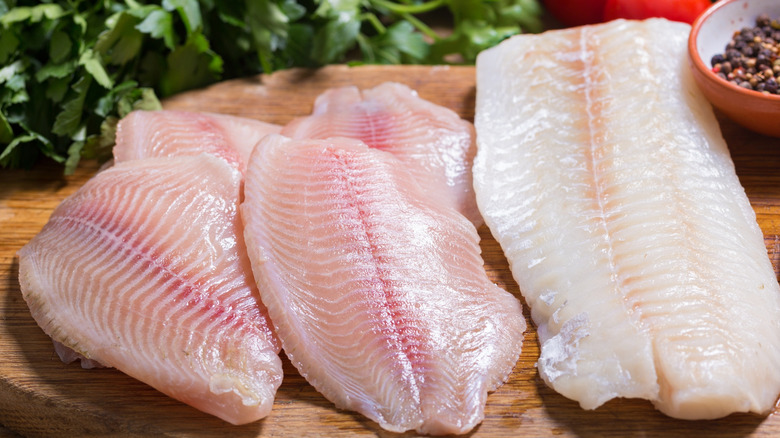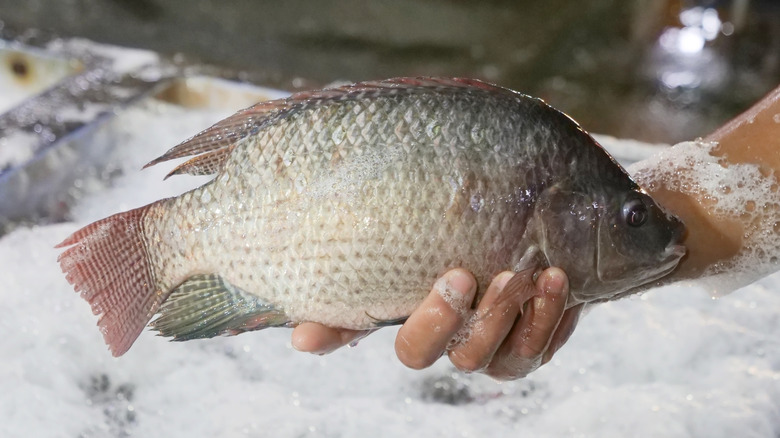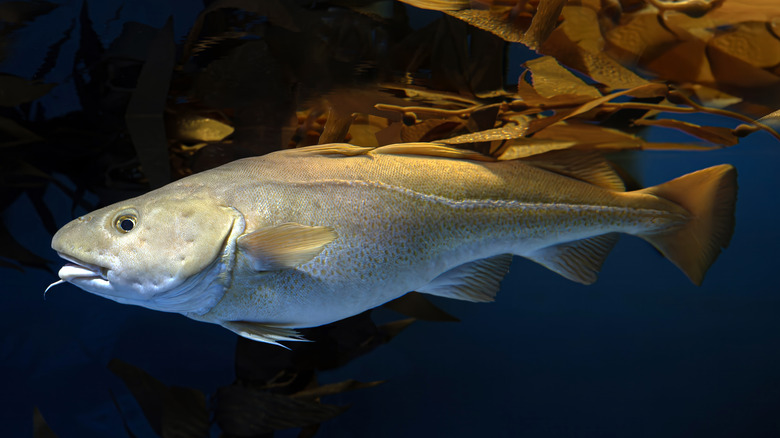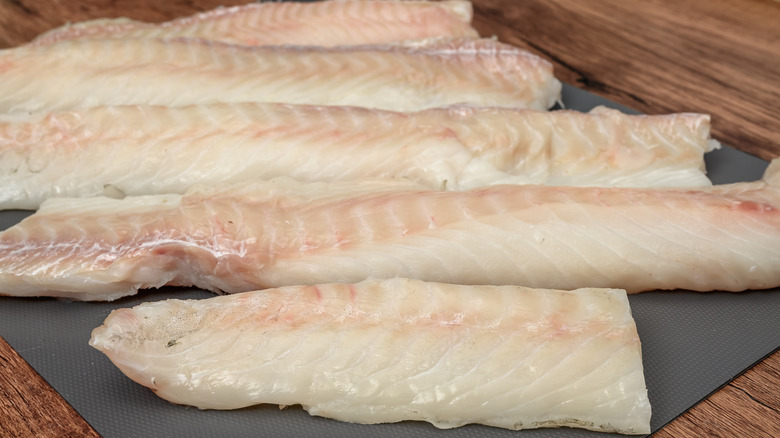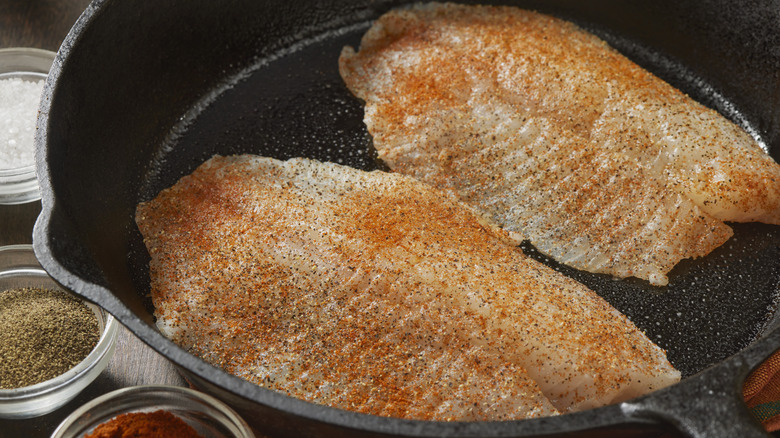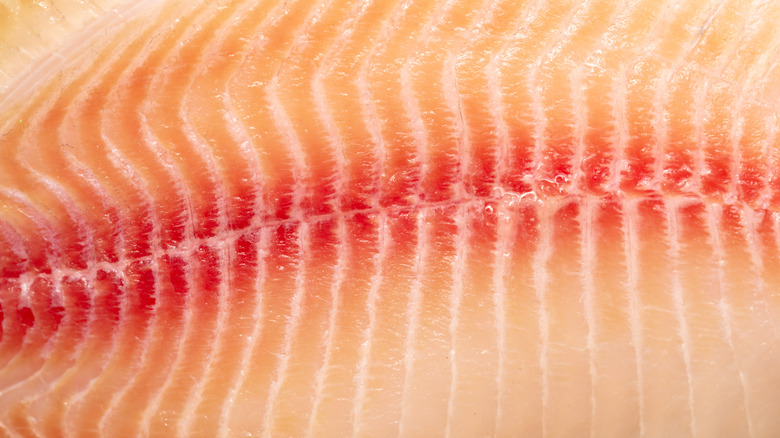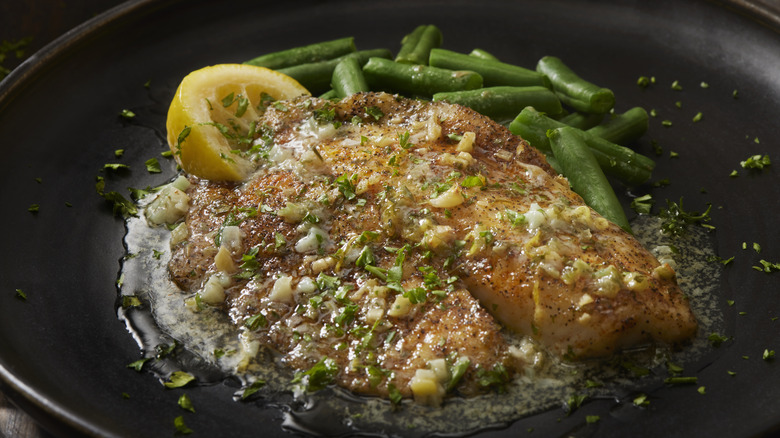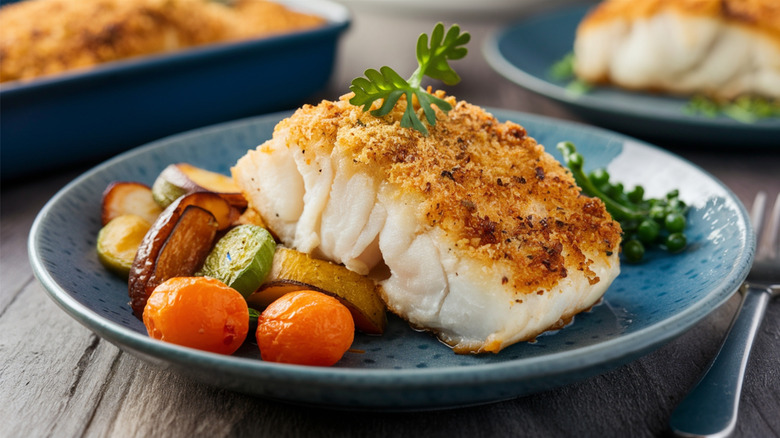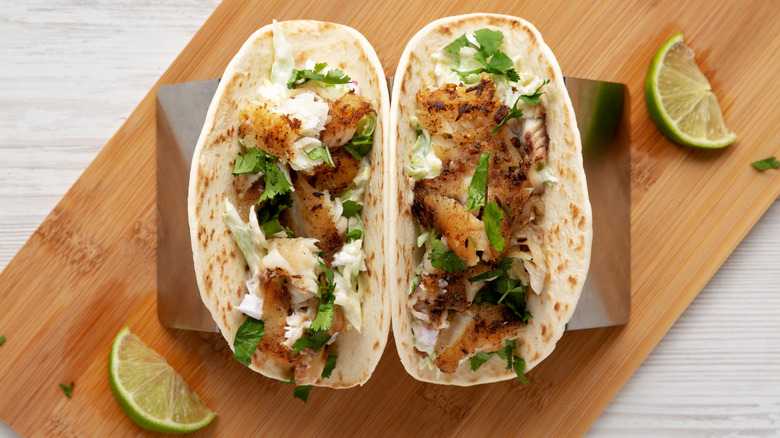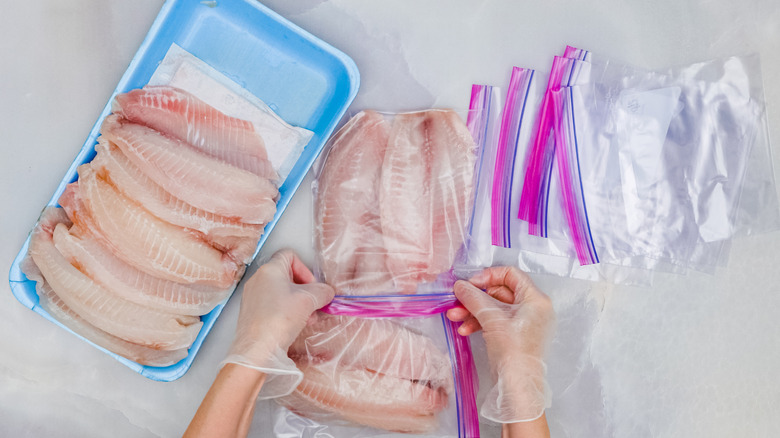Tilapia Vs Cod: Everything You Need To Know About These Popular Fish
At first glance, cod and tilapia look quite similar. After all, they are both mild-tasting white fish. They're both pretty popular too. Even so, these fish are quite different. So, how do they compare regarding flavor, taste, and texture? Is one more expensive than the other, or possibly more nutritious? The answers to these questions and more can be found below.
To truly understand the difference between tilapia and cod, I checked in with a few experts in the field. Athena Davis, marketing manager of the Aquaculture Stewardship Council (ASC) North America, had a lot to say on the matter. If you aren't familiar with their labels, which can be found on seafood nationwide, ASC is the global nonprofit setting the world's strictest standards for responsibly farmed seafood. She really knows her stuff. I also consulted with various team members at Regal Springs, the world's top producer of sustainably raised tilapia. While tilapia is their specialty, they also uncovered lots of helpful information pertaining to cod too.
Whether you want to hone in on your white fish cooking skills or simply know when to pick one over the other, the insights provided by the above experts will point you in the right direction. Keep reading to find out what they said when asked about the differences between tilapia and cod — so the next time you're eyeing these two fish in the grocery store or seafood market you know exactly which one to select.
What is tilapia?
Tilapia is a freshwater fish that, while native to rivers and lakes in Africa, is commonly farmed in the tropical belt because the water temperatures are ideal for growth. According to Elena Piana, group sustainability manager at Regal Springs, "Tilapia is a tropical fish with a long history of being farmed from communities who understood the importance of having access to fresh seafood protein all year round." No wonder it's so well-known and popular. She went on to say, "Some of the earliest evidence of tilapia being grown in a controlled environment dates back to 2,500 years BC in Egypt!" How cool!
"Over the decades tilapia has been introduced around the world via seafood farming, also known as Aquaculture," says Athena Davis, marketing manager of Aquaculture Stewardship Council. As a result, it is seen in regional cuisine all over the world, not just in the tropical belt. A typical tilapia fish ranges from 700 to 800 grams. However, Elena Piana told me, "Regal specializes in growing fish to 1.2 kilograms in Indonesia." Apparently, if you're into extra tender, flaky, and succulent tilapia, she says bigger is better. Keep that in mind the next time you're weighing your options.
What is cod?
Unlike tilapia, which we now know is a freshwater fish, cod is a wild sea fish. Elena Piana, group sustainability manager at Regal Springs told me, "Cod is a cold water fish that likes to live near the bottom of the sea floor." As such, it's much heartier than tilapia. What do I mean by this? Well, for starters, cod is way bigger than tilapia. A single inshore Atlantic cod weighs between 6 and 12 pounds and grows to be as big as 34 inches long. Offshore Atlantic cod are even bigger. They weigh about 25 pounds and some can grow to be as long as 6 feet.
Piana also told me, "There has been some cod farming but it is mainly available as wild caught option." In fact, it is a large part of many fishing economies and it can be caught in the Atlantic, Pacific, and beyond. It may be hard to believe, but four actual wars broke out between Iceland and Great Britain over cod fish. They weren't that long ago either, the first was in 1952. So needless to say, it has been an important part of diets and culture for a long time.
Cod and tilapia look similar but structural integrity varies
Cod and tilapia look a lot alike. That's one of the reasons it's tricky for an amateur consumer to tell them apart. Even so, the structural integrity of the flesh varies. This is not only true when you compare tilapia to cod, but can also be seen when you compare different sources for the same fish. Basically, the quality of fish varies greatly from one company to the next, and as you might suspect, selecting a better quality option leads to a serious improvement in structural integrity.
Elena Piana, Regal Springs, knows a lot about structural integrity because the company's tilapia is labeled premium for a reason. According to her, "Ensuring a high level of welfare is very important to maintain a high seafood fillet quality that does not smell and does not break down." At Regal Springs, they aim to minimize the stress of the fish during growth and harvesting: "We grow our fish in deep freshwater lakes where the fish have ample room to swim and breathe — the level of oxygen is critical to their well-being, and we ensure a good supply from the hatchery to harvest." The company also harvests the fish slowly so the fish stay relaxed and experience as little stress as possible. As a result, the tilapia maintains optimal structural integrity and you get a better quality product.
Tilapia has a more mild, delicate taste than cod
One of the biggest differences between cod and tilapia is taste. However, once it's cooked and dressed up with various seasonings and flavorings, the difference isn't hugely noticeable. You get the most variation before these two fish are doctored up.
As a freshwater fish, "Tilapia is not overwhelmingly fishy. Instead, it is mild — perfect for any recipe where other flavors can take center stage," says Vernon Bradley, head of marketing & media relations for Regal Springs. He went on to say, "Atlantic cod is also mild, but it has a more distinctive milky taste." So, tilapia and cod are similar, but a slight difference can be detected.
Despite the similarities, our experts agree that tilapia has a more neutral, mild taste, making it a fantastic fish for seafood newbies. Athena Davis, marketing manager of the Aquaculture Stewardship Council North America told me, "If you are new to experimenting with seafood, tilapia is an excellent gateway: It cooks quickly, is mild in flavor, and comes out of the oven super tender." Speaking of seafood beginners, Bradley noted that tilapia's light taste also makes it a great choice for kids who aren't big fans of fish. Of course, this neutral flavor means it is quite versatile. Some chefs steer clear of tilapia, but it takes well to a myriad of flavors and seasonings which make it an excellent place for seafood newbies to start.
Neither cod nor tilapia have a strong fishy odor
Obviously, fish is going to smell like what it is: fish. There's no getting around it, at least not until you add aromatic seasonings. Still, some fish have a much more potent fishy odor than others and unsurprisingly, this inherent smell turns a lot of people off. With tilapia and cod, you don't get a lot of the fishy smell though. As Vernon Bradley, head of marketing & media relations at Regal Springs told me, "Like the taste there is no strong odor in Tilapia — again, making it suitable for those who do not like the smell of fish."
Guess what? The same can be said for cod. Compared to many other types of fish, its odor is minimal. It does have an oceanic smell, but it's mild just like tilapia. As you know, this lack of an odor is a huge draw. Maybe that's why cod was once a popular luxury breakfast food – who wants to be punched in the face with a fishy odor first thing in the morning?
If you ever get a strong fishy smell from tilapia or cod, it's a sign that it might be spoiled. Definitely investigate further and think twice before consuming it.
Tilapia's texture is more soft and delicate and cod is somewhat meatier
Okay, so the smell and taste of cod are somewhat alike, but what about texture? Well, as it turns out they can be fairly similar too. However, according to Athena Davis from the Aquaculture Stewardship Council North America, "Tilapia is more soft and delicate, while cod can be a bit meatier." She also notes that cod is a touch firmer, making it more than ideal for grilling and roasting. The softer texture of tilapia is "ideal for quick cooking recipes in the oven and on the stovetop," says Davis.
This seems straightforward enough, but higher-quality tilapia can muddy the waters even more. Vernon Bradley, head of marketing & media relations for Regal Springs, explains that tilapia's texture becomes more like cod when comparing top-tier products. For example, Regal Springs is particularly proud of its unique tilapia loins because the meat falls off the bones in chunky flakes — similar to its heartier rival cod.
If you're looking for a super delicate fish, tilapia is still your best bet. When you want meaty and slightly firm, look to cod. For the best of both worlds, Regal Springs tilapia loins and other premium options might be just what you need to bridge the gap.
Tilapia is typically more affordable than cod
Another major difference between cod and tilapia lies in its price. In general, tilapia is going to come at a lower price. For example, a 12 ounce package of frozen cod fish costs about $13 at Safeway and a 16 ounce package of frozen tilapia only costs around $7. If you're looking to save a few bucks on groceries (and who isn't these days?), tilapia is the obvious choice.
Athena Davis, marketing manager of the Aquaculture Stewardship Council North America, told me tilapia is less expensive than cod because they're plentiful and they grow pretty fast. Plus, you can buy them fresh or frozen. You can with cod too, especially breaded cod, but according to Davis, frozen tilapia can "sometimes be even fresher than the fish counter!" Um ... that's kinda surprising, but for all of our land-locked friends, this is fantastic news. Not only can you opt for tilapia and stay within a strict budget, but frozen doesn't even necessarily sacrifice freshness — that's a win!
Both cod and tilapia are lean and protein-rich but tilapia is the most nutritious of the two
Everyone knows seafood is a great source of lean protein. However, when it comes to comparing tilapia and cod, tilapia takes the win, just not by much. As Johnny Elgin, vice president of quality & safety at Regal Springs, told me, "Cod and Tilapia have very similar nutrition profiles. Both provide around similar amounts of protein, coming in at about 17.8 grams per 100 grams for raw cod and 20 grams per 100 grams for raw tilapia." He also noted that once cooked, tilapia becomes more nutritionally dense and gives you about 26 grams per 100 grams.
In addition to protein, Elgin said, "Tilapia also contains a healthy dose of vitamins and minerals, providing more B12, iron, and selenium than cod." Still, thanks to the presence of omega-3 fatty acids, both fish are considered heart healthy options. Athena Davis, Aquaculture Stewardship Council (ASC), confirmed what Elgin said while also adding vitamin C, vitamin E, calcium, magnesium, and potassium to the list of tilapia's nutritional benefits. Plus, if you want to take your consumerism to the next level, "Choosing tilapia certified and labeled by the ASC can help ensure that the fish you're buying is not just healthy for you, but for the planet too," says Davis.
Both cod and tilapia are readily available in stores
Lucky for us, both tilapia and cod are readily available in just about every grocery store. Whether you go straight to the fishmonger or the frozen aisle is up to you, but you can expect to have options either way.
Our experts offered up a few tips about how to choose the best quality fish. No surprise here, but Athena Davis of the Aquaculture Stewardship Council (ASC) said, "I recommend looking for the ASC sea green label when shopping for farm raised tilapia — which is the most common kind — as it ensures the seafood you're buying was raised according to the world's strictest standards." Essentially, you can count on any fish carrying the label to be backed by responsible water quality, fish health, and dietary standards. It also means the fish can be traced back to its source farm. "When shopping for cod, the Marine Stewardship Council (MSC) blue fish label is a good bet and one I always look for to ensure my cod came from a certified sustainable fishery," says Davis.
Of course, Johnny Elgin, vice president of quality & safety at Regal Springs also backs his products with gusto: "In Regal Springs we have a firm policy: NO TO CHEMICALS!" Other suppliers can't say the same thing. In fact, he noted that other companies have been known to use water treatment chemicals to solve contamination issues and some even use "carbon monoxide gas to artificially enhance color."
What kinds of recipes make cod shine?
Now that you know all about cod, and how it differs from tilapia, you're probably wondering what kind of dishes it's best suited for. Thanks to it being mild and subtly sweet with a flaky texture, there are quite a few. Luckily, many options are well-suited for people new to cooking seafood too, so you don't need to be a pro to whip up delicious cod recipes.
Elizabeth Halle, channel marketing manager for Regal Springs, weighed in on the matter: "Like Tilapia, [cod] can easily absorb other flavors in a dish. It is best used in your favorite seafood soups and stews, or in any recipe for baked or fried fish." So, recipes like salt cod fritters, seafood chowder, Portuguese fish stew, and Cuban-style cod fritters are excellent ways to make the most of cod fish. It also tastes wonderful turned into a cod "BLT" – or if you want to get fancy and test your skills with a torch, black cod brûlée (made with beer and other drool-worthy flavors) is a surefire way to make this tasty fish shine.
What kinds of recipes make tilapia shine?
One of the best things about tilapia is that its mild flavor is extremely versatile. Not only does it take on a world of delicious flavors, but it cooks quickly and you can pair it with just about any ingredients. Athena Davis, marketing manager of the Aquaculture Stewardship Council North America, loves tilapia and she had a few recommendations: "Tilapia's versatility and mild flavor complement countless dishes, from tacos and fajitas to stir-fries and simply seasoned baked fillets. My favorite way to prep an easy tilapia dinner is baked in the oven with a little butter, coarse salt, and lots of fresh lemon and parsley." She also notes that when baked, it comes out of the oven deliciously tender.
Elizabeth Halle, channel marketing manager for Regal Springs, confirms tilapia's cooking versatility: "Since it's such a lean fish, there's no shortage of ways to cook with it: You can prepare it through methods such as baking and broiling to grilling and roasting." It's perfect for a crunchy fried fish sandwich too. She also enjoys its complementary flavor profile and told me it is a super easy fish to work with so you should feel free to experiment and explore an array of different flavor pairings and regional cuisines. Basically, you can go wild with creative ingredients, seasonings, and sauces. Just remember to have fun with it and who knows what inspiring new recipes you'll come up with.
Tilapia and cod can be stored the same way
When it comes to proper storage of cod and tilapia, the differences between the two fish disappear. They should both be eaten fresh for the best quality, taste, and texture overall. When that is not in the cards, both tilapia and cod need to be stored in an airtight container, either in the fridge or freezer. Uncooked fish stays fresh for two days in the fridge. However, if you plan on eating certain fish raw, like with sushi or ceviche, it's best to eat it within 24 hours. Otherwise, quality starts to deteriorate.
Freezing cod and tilapia is also a convenient option. While your fish won't be quite the same as when it is fresh, you can store it in the freezer for a long time. Still, it's best to consume frozen fish within three to eight months after freezing. That is, of course, if you want to get the best taste and texture.

